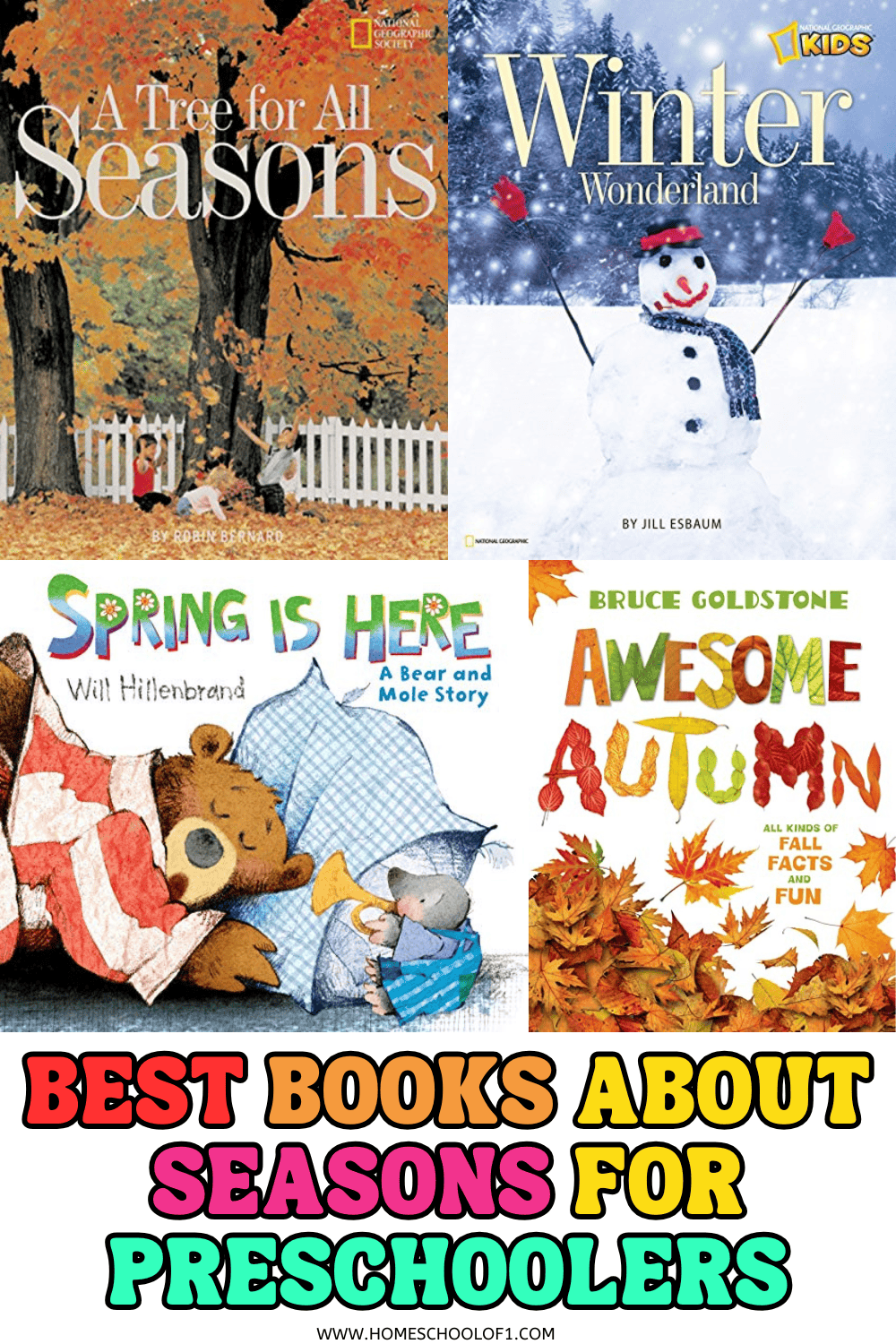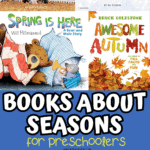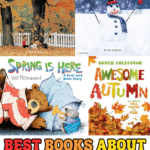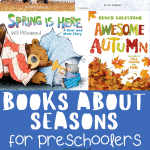25 Best Books About Seasons for Preschoolers
Books about seasons for preschoolers have been a big part of how we’ve explored nature at home, especially when my son was younger.
We’d match what we were reading with what we saw outside—buds on the trees in spring, crunchy leaves in fall, or even puddles after summer storms.
These stories helped him notice small changes in the world around him and made each season feel a little more magical.
If you’re looking for picture books that bring the seasons to life, these titles are perfect for curious little readers.

**This post may contain affiliate links. As an Amazon Associate and a participant in other affiliate programs, I earn a commission on qualifying purchases.**
Preschool Books About Seasons
Seasonal stories have always been a favorite in our home—they’re a simple, fun way to help preschoolers notice how the world changes around them.
From spring flowers to winter snow, each book in this collection captures what makes every season special.
Whether your child enjoys sturdy board books or cozy read-alouds, you’ll find engaging options here that make learning about nature feel exciting and age-appropriate.
This was one of the first books we read when we started talking about seasons. It follows a single tree through all four seasons, and the photos are so real and vivid that my son would point out similar trees on our walks. It’s a simple concept, but it helped him connect what he saw in the book to what was happening outside—especially in the fall, when the leaves started to change.
If your kids are curious about why things change with the seasons, this book is a great fit. We used it as a way to spark conversations while doing our nature scavenger hunts. The text encourages observation in a gentle, engaging way, and it pairs really well with outdoor exploration—especially in spring and fall when the changes are most noticeable.
Pair this book with our nature scavenger hunt to spark even more curiosity.
This was our go-to during the toddler years. It’s bright, simple, and introduces not just the seasons, but weather too—which helped us explain things like “Why is it raining in summer?” or “Why do the leaves fall?” It’s one of those books that feels like a gentle introduction to both science and storytelling.
This is a great book about the weather for younger children.
Leo Lionni’s illustrations are always a hit in our house, and this one feels especially cozy. It captures the quiet beauty of winter without being too wordy. We’d often read it before heading out to play in the snow, and it gave us some fun little things to look for—like snowflakes landing on scarves or icicles hanging from rooftops.
Add a winter themed board game to your studies too for some hands-on fun!
If your preschooler already loves the original Caterpillar story, this seasonal version is a sweet extension. It introduces winter ideas in a very gentle, familiar way. My son loved spotting all the little winter details—mittens, snow, even animal tracks. It was also a nice way to talk about how animals and insects adapt when it gets cold.
This one is packed with gorgeous photography, and I used it more as a “look-and-talk” book than a traditional story. The photos sparked so many questions—especially about animals in winter. We’d read a page and then go search videos or look things up together, which made it a great jumping-off point for learning through conversation.
This one captures that feeling of the first real snowfall—the kind that makes everything quiet and still. The poetic language is lovely, but what stood out most to us were the illustrations. My son used to trace the snowflakes on the pages with his finger, and we’d try to spot those same winter scenes out our window. It’s the kind of book that made winter feel peaceful, not just cold.
We picked this up when we were focusing more on science vocabulary, and it ended up being one of the clearest introductions to what a season actually is. It goes beyond snow to talk about frost, hibernation, and shorter days. It’s a nice mix of bright visuals and simple explanations—great if your preschooler asks a lot of “why” questions.
This one brought a burst of color into our house after a long gray winter. The art is cheerful and familiar, and the story itself is all about noticing the first signs of spring. We’d read it together and then go outside and try to find something new growing. It pairs really well with a springtime memory game or a scavenger hunt.
This book became part of our spring reading tradition. It’s sweet and simple, with the caterpillar discovering flowers, bees, and bright green grass. We used it as a soft way to talk about change and growth—especially when starting seeds or planting in the garden. The familiar character made it feel like a safe, cozy read.
This is one of those books where the rhythm of the language makes it perfect for reading aloud. It gently builds excitement for spring, and the illustrations are full of little details that kids love pointing out—tiny animals, buds on trees, melting snow. It also includes a subtle nod to Easter, which was a nice seasonal tie-in for us.
Spencer’s curiosity reminded me a lot of my son at that age—constantly asking questions and running outside barefoot way too early in the season. This book tells a playful, relatable story about a child experiencing spring, and it felt more personal than most nonfiction titles. The tone is fun without being too silly, which made it a repeat favorite.
This book takes a slightly more informative approach, but it’s still gentle enough for preschoolers. We used it as a starting point for a mini spring nature journal—after reading, we’d go outside and draw what we saw: bugs, blossoms, birds. It helped tie the concepts in the book to real observations, which was especially helpful for a hands-on learner.
This one’s a sweet story of friendship that just happens to take place in spring, and it became one of our favorites for bedtime. My son loved the characters—Bear’s sleepy, Mole’s enthusiastic, and their joy about spring’s arrival was contagious. It felt more like a storybook than an “educational” read, which made it perfect for winding down at the end of the day.
Summer is my son's favorite season, and this book captures everything he loves about it: bright skies, buzzing insects, and the feeling of being outside all day. The poetic language was fun to read aloud, and we often paused to talk about what we’d done that week that matched the page—like spotting bees or hearing birds in the yard.
This is one of our favorite books about summer for preschoolers
This one got pulled out every fall when my son started asking questions about the trees. It’s more scientific than most of the others on this list, but it’s written clearly enough for preschoolers to understand. We paired it with a leaf-collecting activity and even used it to press leaves in a book—simple, but memorable learning.
Another seasonal spin on a classic character! This version has that same familiar style and simplicity, but with an autumn twist—leaves changing, cooler weather, and cozy imagery. My son liked comparing the seasonal books in this series, and it helped him see the year as a cycle rather than isolated parts.
Why not create some special memories with our free fall handprint template.
This book is packed with facts, photos, and little tidbits, so we didn’t always read it cover to cover. Instead, we’d flip to a page that matched what we were doing—apple picking, raking leaves, spotting animals—and read just that section. It’s one of those books that grows with your child and can be reused in different ways year after year.
This book reads like a quiet walk through autumn. The illustrations are rich and warm, and the language has a rhythm that made my son slow down and really listen. It led to some great conversations—Why do animals get ready for winter? Why do leaves fall? It felt less like a lesson and more like noticing things together.
We read this one right before visiting an apple orchard, and it totally changed how my son experienced the trip. He remembered parts of the book while picking apples and even asked to make applesauce after. The story combines facts with fun, and the illustrations are cheerful without being over-the-top.
This one had us laughing out loud. The squirrel is convinced someone is stealing his leaves, and the story turns into a silly little mystery that sneaks in some basic science. It’s fun, lighthearted, and perfect for easing into conversations about fall changes—without feeling like a science book.
This has such a peaceful tone, and the transition from summer to fall is beautifully done. My son especially loved the way the girl in the story “talks” to nature—something he started mimicking during our walks. The seasonal shift is shown gently and visually, which helped him understand what to expect outdoors.
This book is pretty straightforward, but we liked using it as a quick refresher before starting new seasonal activities. The images are bold and clear, and it covers the basics—weather, clothes, animals—in a way that’s easy for preschoolers to connect with. We kept it in a seasonal book bin and came back to it often.
This one feels like a love letter to trees. It’s written in rhyme, which helped with rhythm and flow during read-aloud time, and the focus on the “magic” of trees gave us a fun way to talk about their importance. After reading it, we made bark rubbings and talked about how trees change during the year—simple but memorable activities that made the message stick.
This book felt like a cozy snapshot of childhood in the fall. The mention of crunchy leaves and sweater weather instantly brought back memories of our own leaf pile adventures. It’s less about the science of the seasons and more about the simple joys kids experience as the weather shifts—which made it a lovely read to share during those in-between moments, like after a walk or before quiet time.
Last Updated on 7 April 2025 by Clare Brown




























